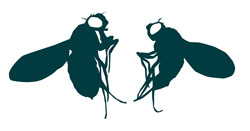Of flies and men

The female (left) fruit fly, Drosophila melanogaster, is larger than the male (right).<br> Image credit: EMBL<br>
What do you get when you dissect 10 000 fruit-fly larvae? A team of researchers led by the EMBL- European Bioinformatics Institute (EMBL-EBI) in the UK and the Max Planck Institute of Immunobiology and Epigenetics (MPI) in Freiburg, Germany has discovered a way in which cells can adjust the activity of many different genes at once. Their findings, published online today in Science, overturn commonly held views and reveal an important mechanism behind gender differences.
Asifa Akhtar’s laboratory, previously at EMBL now at MPI, studies precisely how flies regulate an important set of genes. Females have two X chromosomes while males have only one, so the genes on the female X chromosomes somehow need to be kept from producing twice as many proteins as those on the male X chromosome. Male fruit flies get around this by making their X chromosome’s genes work double time: an epigenetic enzyme doubles the output of thousands of different genes. But just how much that doubled output is can vary tremendously from one gene to the next.
“Imagine that you have thousands of half-filled glasses of all different sizes and shapes,” explains Nick Luscombe, who led the work at EMBL-EBI. “Now imagine that you have to fill them all up to the top at the same time. This is an incredibly complex mechanism.”
To see how genes are expressed, scientists try to pinpoint signals that show when a gene increases its output. In most studies of this kind, this output is increased by a factor of between 10 and 100 when a gene is being expressed. In this study, the signal involved is miniscule: an increase of only a factor of two.
Observing such a faint signal is a major challenge. But thanks to the painstaking fly-larvae dissection efforts of graduate student Thomas Conrad, combined with the detailed analytical efforts of Florence Cavalli and Juanma Vaquerizas, the team gathered enough material to measure this output and compare males and females directly.
The scientists found twice as many DNA-transcribing (reading) proteins – known as polymerases – attached to the male X chromosome as to the female version. This means that the difference between males and females is rooted in the beginning of the transcription process, when the polymerase first binds to the DNA. This goes against the commonly held view that the regulation mechanism is kicked off during transcription.
“A factor of two appears minuscule, so it is not easy to measure accurately,” says Akhtar. “We were really doing a bulk analysis of several hundred genes, and that required a lot of careful bioinformatics analysis. Our group would run experiments, Nick’s would analyse the data, and then we would decide on new experiments together to be sure that what we were seeing was real.”
Discovering the machinery that doubles the expression of male X-chromosome genes could well have implications that go far beyond the humble fly. Speaking more technically, Luscombe says: “This is the first direct, clear mechanism that links a histone modification and the activity of a polymerase across thousands of genes”.
Looking into future directions, Akhtar says: “We now need to look more deeply into what makes this kind of mass regulation possible, and how it fits in with other means cells may have to fine-tune their use of genetic information.”
Published online in Science on 19 July 2012. DOI: 10.1126/science.1221428.
Policy regarding use
EMBL press and picture releases including photographs, graphics, movies and videos are copyrighted by EMBL. They may be freely reprinted and distributed for non-commercial use via print, broadcast and electronic media, provided that proper attribution to authors, photographers and designers is made.
Contacts:
contactpress@ebi.ac.uk
Mary Todd Bergman
Senior Communications Officer
EMBL-European Bioinformatics Institute
Tel: +44 (0)1223 494 665
mary@ebi.ac.uk
www.ebi.ac.uk/information/news
Twitter: @emblebi
Facebook: /EMBLEBI
Sonia Furtado Neves
EMBL Press Officer
Meyerhofstr. 1, 69117 Heidelberg, Germany
Tel.: +49 (0)6221 387 8263
Fax: +49 (0)6221 387 8525
sonia.furtado@embl.de
Media Contact
All latest news from the category: Life Sciences and Chemistry
Articles and reports from the Life Sciences and chemistry area deal with applied and basic research into modern biology, chemistry and human medicine.
Valuable information can be found on a range of life sciences fields including bacteriology, biochemistry, bionics, bioinformatics, biophysics, biotechnology, genetics, geobotany, human biology, marine biology, microbiology, molecular biology, cellular biology, zoology, bioinorganic chemistry, microchemistry and environmental chemistry.
Newest articles

Properties of new materials for microchips
… can now be measured well. Reseachers of Delft University of Technology demonstrated measuring performance properties of ultrathin silicon membranes. Making ever smaller and more powerful chips requires new ultrathin…

Floating solar’s potential
… to support sustainable development by addressing climate, water, and energy goals holistically. A new study published this week in Nature Energy raises the potential for floating solar photovoltaics (FPV)…

Skyrmions move at record speeds
… a step towards the computing of the future. An international research team led by scientists from the CNRS1 has discovered that the magnetic nanobubbles2 known as skyrmions can be…





















